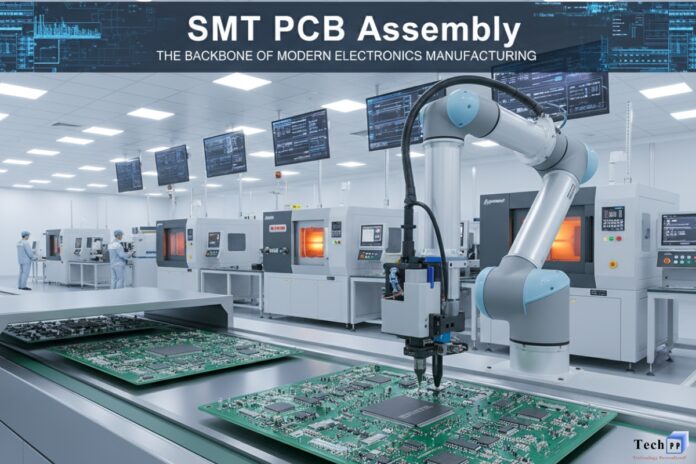In the fast-paced world of electronics manufacturing, SMT PCB Assembly (Surface Mount Technology Printed Circuit Board Assembly) has revolutionized how electronic components are mounted and connected. SMT allows manufacturers to produce smaller, lighter, and more reliable electronic devices — from smartphones and wearables to industrial control systems and automotive electronics. The rise of automation and high-precision production lines has made SMT the industry standard for assembling complex circuit boards with exceptional accuracy and consistency.
Unlike traditional through-hole technology, where component leads are inserted into holes drilled through the board, SMT involves directly mounting components onto the PCB surface. This approach improves performance, reduces cost, and enables denser circuit designs — essential for today’s compact, high-functionality electronics.
What Is SMT PCB Assembly?
SMT PCB Assembly is the process of placing and soldering electronic components (known as surface-mount devices or SMDs) directly onto the surface of a printed circuit board. This method eliminates the need for component leads to pass through holes, simplifying the overall assembly process while increasing manufacturing efficiency.
SMT components are usually much smaller than their through-hole counterparts, enabling engineers to pack more functionality into limited board space. These components can range from tiny resistors and capacitors to integrated circuits (ICs) and microcontrollers that power today’s intelligent devices.
The SMT PCB Assembly Process
1. Solder Paste Printing
The process begins with applying solder paste to the PCB’s copper pads using a stencil printer. The solder paste — a mixture of tin, flux, and other metals — acts as an adhesive and electrical connection medium for components. Precision in this step is critical to ensure accurate placement and strong solder joints later in the process.
2. Component Placement
Next, automated pick-and-place machines position the surface-mount components onto the PCB with remarkable speed and precision. These machines use computer vision systems to align parts accurately, handling thousands of components per hour.
3. Reflow Soldering
Once all components are placed, the board passes through a reflow oven. The heat melts the solder paste, forming permanent, conductive bonds between the components and the PCB. Controlled heating profiles prevent overheating and ensure consistent results across every board.
4. Inspection and Quality Control
After soldering, the boards undergo inspection to detect any misaligned components, solder bridges, or defects. Automated Optical Inspection (AOI) systems, X-ray inspection, and functional testing ensure the finished board meets design and performance requirements.
Advantages of SMT PCB Assembly
1. Compact and Lightweight Designs
SMT allows for smaller components and denser layouts, making it ideal for compact electronic devices. This leads to reduced product size and weight — essential in applications like smartphones, wearables, and IoT devices.
2. Higher Production Efficiency
The automation used in SMT PCB Assembly increases manufacturing speed and consistency. With pick-and-place machines handling thousands of components per hour, production lines can achieve high throughput with minimal human error.
3. Better Electrical Performance
Surface-mounted components have shorter lead lengths, reducing signal distortion and improving electrical performance. This characteristic is crucial for high-speed and high-frequency circuits.
4. Cost Efficiency
Since SMT eliminates the need for drilled holes and manual placement, it significantly reduces production costs. The ability to fit more components onto a single board also saves material and assembly expenses.
5. Enhanced Reliability
With fewer mechanical connections and stronger solder joints, SMT assemblies are more resistant to vibration, shock, and thermal stress, ensuring long-term durability.
Applications of SMT PCB Assembly
The flexibility and precision of SMT PCB Assembly make it suitable for a wide range of industries and products, including:
- Consumer Electronics: Smartphones, laptops, televisions, and wearables.
- Automotive Systems: Engine control units, infotainment systems, and ADAS modules.
- Medical Devices: Portable monitors, diagnostic tools, and imaging systems.
- Telecommunications: Routers, switches, and networking equipment.
- Industrial Automation: Sensors, control boards, and robotics.
Each of these applications benefits from SMT’s ability to support miniaturization and high-speed performance without sacrificing reliability.
Key Design Considerations for SMT PCB Assembly
1. Component Placement Accuracy
Precise component alignment is crucial to prevent solder bridging and electrical shorts. Design engineers must carefully define pad sizes and spacing to ensure proper soldering.
2. Thermal Management
As components are densely packed, managing heat dissipation becomes vital. Designers often use thermal vias, heat sinks, and copper planes to maintain optimal operating temperatures.
3. Material Selection
The PCB substrate material influences the overall stability of the assembly. FR-4 is widely used, but high-performance materials like Rogers or polyimide may be necessary for demanding applications.
4. Double-Sided Assembly
Many modern PCBs require components on both sides to save space. This process involves careful thermal profiling to prevent previously soldered components from detaching during the second reflow cycle.
5. Testing and Validation
Comprehensive testing — including in-circuit testing (ICT), functional tests, and burn-in tests — ensures that the assembled boards operate reliably under real-world conditions.
The Role of Automation in SMT PCB Assembly
Automation lies at the heart of SMT PCB Assembly. Advanced pick-and-place machines, 3D solder paste inspection, and automated optical inspection systems have transformed PCB manufacturing into a high-precision process. Artificial intelligence (AI) and machine learning (ML) technologies are also being integrated to improve defect detection, predictive maintenance, and process optimization.
This automation not only enhances accuracy and productivity but also ensures consistency across large-scale production runs — a key requirement for industries like telecommunications and automotive electronics.
Future Trends in SMT PCB Assembly
The future of SMT PCB Assembly points toward miniaturization, flexible electronics, and environmentally friendly soldering techniques. Innovations such as 3D component packaging, advanced reflow ovens, and AI-driven quality control are set to make SMT even more efficient and sustainable.
As devices become smarter and more interconnected, manufacturers will continue refining SMT processes to meet the growing demand for high-performance, compact, and energy-efficient electronic systems.
Conclusion
The SMT PCB Assembly process forms the foundation of nearly every modern electronic device, offering unmatched precision, scalability, and performance. From initial design to final inspection, every step demands advanced technology, technical expertise, and strict quality control.
If your business is looking to outsource reliable and high-quality assembly, working with a professional provider of PCB assembly services can give you a competitive advantage. With state-of-the-art facilities, skilled engineers, and years of manufacturing experience, these experts deliver efficient and cost-effective SMT PCB Assembly solutions tailored to your project’s unique requirements.


